Winding and setting your American and Swiss pocket watch
Contact Us Winding / Setting TestimonialsContact Terry at watchrepair.cc
Antique pocket watches come in different operational configurations and designs:
An open faced model - with it's dial readily available to read, or a hunter's model - with the spring loaded covering flap.Open face and hunters pocket watches were designed and manufactured with two different methods to change the time appearing on their dials: stem set and lever set. Each requires different setting methods.
Wind your watch fully before you conduct any time change.
Stem set pocket watch operation:
Stem set antique American pocket watches only require that their winding crown be pulled out and away from their case - to transition them from the standard winding position into the time setting position, which is most typical in the setting of time on most watches, especially wrist watches. After pulling it's crown into the setting position simply turn it's crown to the desired time, and push the crown in toward the body of the watch thus returning your watch to the winding position. This winding position is the where all mechanical watches want to remain during their normal time keeping operation.Lever set pocket watch operation:
The alternative method of setting the time on other antique pocket watches doesn't employ this above method, but rather a very different one. In all American Railroad grade watches a setting lever is used.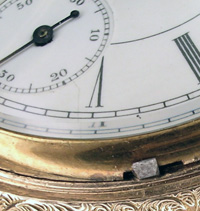
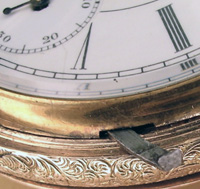
Hunters model lever set pocket watch time change operation:
Should your vintage American pocket watch be a hunters style watch, you'll find a very small metal lever protruding from near the 4:00 ledge of the bezel (which houses the crystal). Pull this lever out and away from your watch nearly an 1/8 inch, and then simply turn it's winding crown to a desired time. No need to pull a crown out into the, "setting position" on any lever set watch.To return your lever-set pocket watch back to timekeeping service, simply push this small lever back in- flush to it's bezel. Your lever set hunter's pocket watch time change is concluded.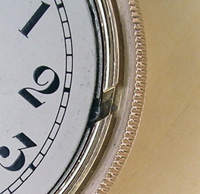
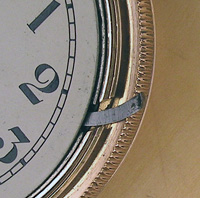
Open face model lever set pocket watch time change operation:
Open face pocket watches are often synonymous with certified Railroad timepieces. Many of these critical timing instruments and were made with a special built-in safety feature that defeats any possibility of accidental time change while in a pocket or otherwise. To adjust the time on your open face lever set pocket watch, special care must be taken. Changing the time on this type of watch requires that you unscrew it's bezel (which houses it's crystal) in a counter clockwise direction and remove it completely from the watch, now exposing it's naked dial and hands. You'll see a small steel lever near the edge of it's exposed dial - either near the 2:00 or 4:30 position -based on the model. With a thumbnail, carefully pull this setting lever out and away from the edge of the dial - where it's located and then simply turn the crown to the desired time. Push the set lever back in after making this time adjustment and carefully screw it's bezel/crystal back onto the top of the watch case. Be careful not to touch the hands of the watch. This is how Railroad men and the companies that made these distinctive watches were assured that only intentional time changes were made to their watches during their use to avoid catastrophic train wrecks caused by such accidental time changes.Key Wind and Key Set Pocket watch operation:
Early Swiss and American pocket watches weren't designed to allow their owners to simply wind their pocket watch and set their time by use of the crown. These early watches required a key to undertake time setting and mainspring winding - just like clocks of their day. These watches need a properly sized key to complete these operations.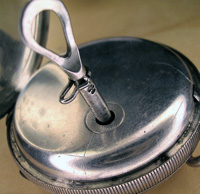
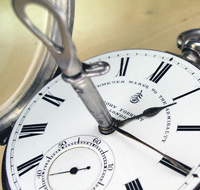 To wind a key wind / key set pocket watch, you'll need to carefully pry
it's rear case cover open to reveal a port hole that will accommodate it's
winding key. Once open, simply push the key into this port and wind
in a clockwise direction. You'll know when you've wound enough, the
key will stop winding. To set the time appearing on the dial, you'll
need to carefully pry open it's hinged bezel - which contains it's crystal.
Once the bezel swings open to reveal it's naked dial, - seat the key
onto the hub that it's hour and minute hand are attached to. Turn
in either direction to attain the desired time. Naturally close it's hinged
bezel so that it snaps tightly - and if it's a hunters case, snap it's
covering flap, and you've successfully set your key wind / key set
pocket watch for operation.
To wind a key wind / key set pocket watch, you'll need to carefully pry
it's rear case cover open to reveal a port hole that will accommodate it's
winding key. Once open, simply push the key into this port and wind
in a clockwise direction. You'll know when you've wound enough, the
key will stop winding. To set the time appearing on the dial, you'll
need to carefully pry open it's hinged bezel - which contains it's crystal.
Once the bezel swings open to reveal it's naked dial, - seat the key
onto the hub that it's hour and minute hand are attached to. Turn
in either direction to attain the desired time. Naturally close it's hinged
bezel so that it snaps tightly - and if it's a hunters case, snap it's
covering flap, and you've successfully set your key wind / key set
pocket watch for operation.
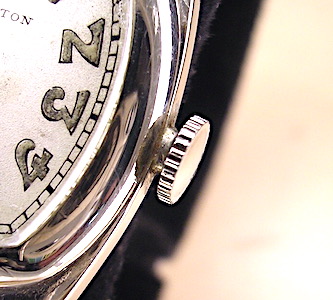
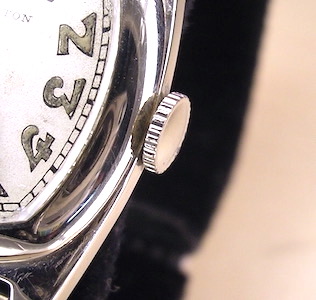
Early Nail Set pocket watch setting instructions:
Early Swiss pocket watches employed a special feature that you'll need to become familiar with before you can properly set their time. As you see in the photo, a small yet protected button appears on the side of the watches case - most often near the 4:00 position in hunters style pocket watches and at the 1:00 position in open face pocket watches. With a thumbnail, simply depress this button "in" towards the body of the watch - and while keeping this button pushed in - turn it's crown to the desired time. Release this button an your watch will return to it's proper winding position.Setting and Winding your Swiss & American Wrist Watch:
If you were born after 1965, chances are good that you've never wound a mechanical watch in your life. Battery operated portable timepieces made and marketed in and after America's Bicentennial accounted for this.
While most of those early battery operated wrist watches were dependable and durable, few of those timepieces survive today. Many of the mechanical wrist watches that preceded that battery operated era still survive today. Let's learn how to operate them.
Manual wind wrist watch winding:
- It's best to wind your watch while it's not on your wrist. Winding your watch on your wrist causes uneven pressure against the winding parts of the watch and can cause internal wear. Always remove your watch from your wrist before winding or time set changes.
- Hold your watch in your passive hand and wind with your dominant hand. Grasp it's winding crown with your thumb and forefinger and wind it's crown it a CW (clock-wise) direction. The winding mechanics of your watch will allow for a the “back & forth” CW/CCW motion of it's winding crown - so that you can wind your watch without need of letting go of the crown.
- Wind your watch fully, until it'll wind no more - every morning that you plan it's use. Don't worry about harming your watch by “over-winding” it. When the old watchmakers saw that the new owner / operator of a such a watch was timid or inexperienced while winding their manual wind wrist watch, they'd blurt out: “ wind it like you're mad at it “ It would take pliers and great strength to harm your watch by insensitive winding of it's crown. Wind your watch to the very end of it's mainspring and then stop. Pay attention, you'll feel the winding operation of it's crown come to an end. Soon you'll be an old hand at it.
- Replenish it's lost mainspring strength by it ticking throughout the day by fully winding your watch before retiring for the evening. This allow your watch to run accurately overnight and greet you in the morning with dependable time.
Setting the time of your vintage and antique wrist watch:
The same crown that is used to wind your watch also sets the time on your watch.
Again, while holding your wrist watch in your passive hand, use the dominant forefinger and thumb to pull the crown out and away from the body of your wrist watch. Often a small bit of a thumbnail and forefinger nail can make the grasping of your crown a bit easier for this operation. The distance of the pull of the crown is very short. A confident yet short tug of the crown is all that you'll need. Once you feel the snap of the transition between the winding mode to the setting mode, you're ready then to rotate the crown in a CW (clock-wise) direction to the desired time. Once you've matched the time on your watch to a “standard”, simply yet confidently push it's crown back in towards the body of the watch until you feel the positive click of the watch returning back to the winding mode: the position of the crown that you'll leave it in during normal use. There you have it. Winding and setting your wrist watch. Good show, mate.
I specialize in the restoration and servicing of antique mechanical watches. Please feel free to visit my Pocket Watch Repair services page to learn more about how we can work together to return your antique pocket watch back to it's proper and dependable condition:
https://www.watchrepair.cc/pocketwatches.html

|
Contact terry@watchrepair.cc | ||
| Watch Repair Services Watch Case Repair Services For Wrist Watches For Pocket Watches Military Watches Chronograph Repair Services |
Mailing Instructions Shipping Instructions Contact WatchRepair.cc Home |
Everything Else Meet the Watchmaker How A Watch Works |
All rights RESERVED. All material on this Website, including text, photographs, graphics, code and or software, are protected by international copyright and trademark laws. Unauthorized use is not permitted. You may not copy, modify, republish, reproduce, post, distribute or transmit material on this Web Site, in any manner.
www.watchrepair.cc





